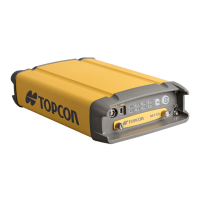General Details
44
P/N: 1004636-01
Specifications
External power
supply adapter
rating
Input: 100-240 VAC, 50-60 Hz, 0.8A
Output: +12VDC/2.5A (5A preferred)
Communication
Serial ODU-7: RS232, RX/TX, RTS/CTS
DB-9: RS232, RX/TX, RTS/CTS, RS232/RS422, RX/TX, RTS/CTS
USB 2 ports; USB Mini-B 2.0 (device) and USB Type-A (host)
Wi-Fi 802.11b Client/AP
Bluetooth v2.1 + EDR
Cellular
e
Yes. GSM/GPRS/EDGE/UMTS/3G/CDMA enabled
Ethernet RJ45
Survey Accuracy
f
Static
(post-processed)
H: 3 mm + 0.1 ppm (x baseline distance)
V: 3.5 mm + 0.4 ppm (x baseline distance)
Kinematic, RTK L1 +L2:
H: 8 mm + 1 ppm
V: 15 mm + 1 ppm
DGPS
H: 0.4 m
V: 0.6 m
SBAS
H: 1.0 m
V: 1.5 m
Cold start
Warm start
Reacquisition
<40 sec.
<20 sec.
<1 sec.
RTK Time-to-
First-Fix (TTFF)
<20 sec.
a. Vanguard ASIC includes two dedicated channels for L-Band signal tracking. The Net-G5 receiver does not support L-
Band signal tracking.
b. CMR/CMR+ is a third-party proprietary format. Use of this format is not recommended and performance cannot be
guaranteed. Use of industry standard RTCM 3.x is always recommended for optimal performance.
c. 100 Hz operation can be supported for custom applications. For more information, contact your dealer.
d. 9 to 28 VDC is the operating range of the external power source when the receiver is on. To turn the receiver on, the
power input must be between 8 to 30 VDC. To charge the internal batteries, the external power input must be greater
than 12 VDC.
e. Cellular modem functionality will be added in a later version of firmware.
f. Accuracy will vary depending on the number of satellites used, obstructions, satellite geometry (PDOP), occupation
time, multipath effects, and atmospheric conditions. Performance may be degraded in conditions with high Ionospheric
activity, extreme multipath, or under dense foliage. For maximum system accuracy, always follow best practices for
GNSS data collections.
Table 7. General Receiver Specifications

